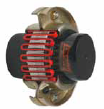The next info is critical when generating a Grid coupling choice:
Description of motor or engine, the horse energy (or KW), and RPM at slowest coupling pace even though under load
Description in the driven products
Shaft and keyway sizes as well as form of match for driver and driven products (clearance or interference)**
Shaft separation (BSE)
Physical room limitations (see Application Worksheet)
Decide what the environmental disorders will probably be, this kind of as temperature, corrosive circumstances, interference from surrounding structures, and so on.
By default, sizes 1020 – 1090 will likely be clearance match, sizes 1100 – 1200 will likely be interference match.
** Machines all bores and keyways to meet the dimensional and tolerance specs per ANSI/AGMA 9002-B04 for inch bores, or ISO 286-2 for metric bores.
Standard grid couplings include two grid hubs, a grid spring, and also a cover assembly. Once the shaft separation demands a spacer design coupling, the coupling will include two shaft hubs, two spacer hubs, a grid spring, and also a horizontal cover assembly.
Formulas Made use of To Calculate Torque:
Application Torque (in-lbs) = ( horse power x 63025 ) /RPM
Application Torque (Nm) = ( horse electrical power x 9550 ) /RPM
Assortment Torque = Application Torque x Services Issue
High Peak Loads and Brake Applications
For applications where substantial peak loads or large braking torques could be current, the following added info will likely be needed:
Procedure peak torque and frequency
Duty cycle
Brake torque rating
The choice torque formula is much like the formula proven above except the application torque needs to be doubled just before applying the  services component.
services component.
Application Torque (in-lbs) = ( horse electrical power x 63025 ) /RPM
Application Torque (Nm) = ( horse energy x 9550 ) /RPM
Choice Torque = two x Application Torque x Services Element
Techniques In Picking out A Grid Coupling
Stage one: Figure out the application torque utilizing the formula proven over.
Step two: Select the Support Aspect from your charts .
For applications not displayed utilize the chart proven for the proper. Ascertain the Variety Torque using the formula proven above.
Step 3: Utilizing the variety torque as calculated, refer on the Performance Chart
Step 4: Assess the maximum bore for that size picked and be certain the needed bore sizes usually do not exceed the maximum allowable. Should the expected bore dimension is more substantial, phase as much as the following dimension coupling and check to discover in the event the bore sizes will match.
Phase five: Working with the selected coupling dimension, evaluate the bore and keyway sizes
Step six: Speak to your local industrial supplier together with the portion numbers to place sizes with the charts for UPC aspect numbers.
